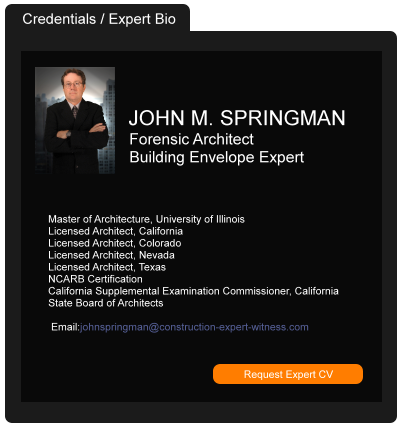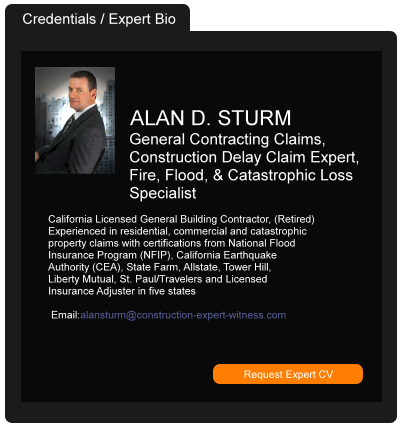GE to Repay $87 Million for Scaled-Back Headquarters Plan
February 27, 2019 —
Rick Clough - BloombergGeneral Electric Co. will reimburse the state of Massachusetts for funds used to develop the manufacturer’s future headquarters, a project that is now being scaled back under Chief Executive Officer Larry Culp.
GE and the state will jointly sell the property in Boston’s Fort Point neighborhood where the company will make its future home, according to an agreement revealed Thursday. GE still plans to move into the campus later this year -- as a tenant rather than owner -- but it’s scrapping plans to build an adjacent 12-story tower.
Read the court decisionRead the full story...Reprinted courtesy of
Rick Clough, Bloomberg
ASCE Joins White House Summit on Building Climate-Resilient Communities
October 09, 2023 —
The American Society of Civil EngineersRESTON, Va. – The White House Climate Policy Office hosted the Summit on Building Climate Resilient Communities today and unveiled its
National Climate Resilience Framework for communities to build more resiliently as they face increasingly severe weather events. The framework features comprehensive recommendations and opportunities for action, including partnerships between federal agencies and leading standards development organizations such as the
American Society of Civil Engineers (ASCE), to improve the resilience of buildings and other infrastructure. ASCE president Maria Lehman, P.E., was in attendance for the Summit.
ASCE's most widely adopted standard,
ASCE 7-22, is the primary reference of structural design requirements in all U.S. building codes and is updated every six years to reflect the latest data and trends presented by an ever-changing climate. Its most recent update, published in 2022, includes updates to environmental hazards used for building design including new wind speeds along the hurricane coastline, a completely new chapter for tornado loads, and the most substantial update to its chapter on flood loads since the inception of ASCE 7-22 – calling for structures to be built to withstand 500-year floods rather than the previous standard of 100-year flood mitigation.
Although modern codes and standards, such as ASCE 7-22, can mitigate climate hazards, many communities throughout the U.S. have not yet adopted these practices. The new White House framework calls for ensuring federal funding requires climate-resilient infrastructure investments by encouraging government at all levels to adopt consensus-based engineering standards, which would go a long way towards addressing vulnerabilities posed by future climate impacts.
ASCE, in conjunction with industry leaders represented at the Summit, supports federal efforts to improve climate data, enforce the most stringent codes and standards, and provide technical assistance to building and infrastructure stakeholders. To learn more about environmental hazard mitigation resources, follow
ASCE's Pathways to Resilient Communities Toolkit, a plain-language guide for federal, state, and local leaders as they seek out standards, best practices, data, and strategies that can be implemented to safeguard communities across the country from increasingly severe weather events.
ABOUT THE AMERICAN SOCIETY OF CIVIL ENGINEERS
Founded in 1852, the American Society of Civil Engineers represents more than 150,000 civil engineers worldwide and is America's oldest national engineering society. ASCE works to raise awareness of the need to maintain and modernize the nation's infrastructure using sustainable and resilient practices, advocates for increasing and optimizing investment in infrastructure, and improve engineering knowledge and competency. For more information, visit www.asce.org or www.infrastructurereportcard.org and follow us on Twitter, @ASCETweets and @ASCEGovRel.
Read the court decisionRead the full story...Reprinted courtesy of
Burden to Prove Exception to Exclusion Falls on Insured
April 19, 2022 —
Tred R. Eyerly - Insurance Law HawaiiIn a dispute between two insurers, the Ninth Circuit relied upon Nevada law in finding that the burden of proving that an exception to the exclusion applies was on the insured. Zurich Am. Ins. Co. v. Ironshore Specialty Ins. Co., 2022 U.S. App. LEXIS 1626 (9th Cir. Jan. 20, 2022).
Ironshore insured seven subcontractors. The policy included an exclusion providing there was no coverage for any property damage for the subcontractors' for "work performed prior to the policy inception." An exception to the exclusion provided that the exclusion did not apply to property damage that was "sudden and accidental and takes place within the policy period."
The seven subcontractors were sued for work they had performed. Zurich defended and indemnified the subcontractors. Zurich then sued Ironshore seeking contribution and indemnification for defense and settlement costs. The parties stipulated that all construction work at issue had been completed before the inception of Ironshore's policy and that none of the complaints against the subcontractors alleged that sudden and accidental damage had occurred after the inception of Ironshore's policy.
Read the court decisionRead the full story...Reprinted courtesy of
Tred R. Eyerly, Damon Key Leong Kupchak HastertMr. Eyerly may be contacted at
te@hawaiilawyer.com
A Closer Look at an HOA Board Member’s Duty to Homeowners
October 10, 2013 —
Derek Lindenschmidt — Higgins, Hopkins, McLain & Roswell, LLC.Whenever a homeowner association (HOA) starts thinking in terms of a construction defect lawsuit against its developer and/or builder, its board members will inevitably be confronted with the purported risk and liability to their homeowners if they do not pursue the alleged defects and deficiencies brought to their attention.
Not surprisingly, the board members are on occasion led to believe that pursuing such claims is synonymous with acting in the homeowners’ “best interests.” Further—and unfortunately—board members often feel as though they will breach their obligation to the homeowners if theydon’t agree to proceed with such claims.
Nevertheless, how well do we really know what the board members’ duty actually consists of, when it applies, and what potential liability exists for a board member’s breach of same? The answers might surprise you.
Read the court decisionRead the full story...Reprinted courtesy of
Derek LindenschmidtDerek Lindenschmidt can be contacted at
lindenschmidt@hhmrlaw.com
Florida’s Supreme Court Resolves Conflicting Appellate Court Decisions on Concurrent Causation
December 21, 2016 —
Afua S. Akoto – Saxe Doernberger & Vita, P.C.The Supreme Court of Florida kicked off December with an opinion that determined which theory of recovery applies when multiple perils combine to create a loss, and at least one of those perils is excluded by the terms of a policy. In Sebo v. American Home Assurance Company, Inc.,1 the court resolved the conflict between the Florida Appellate Courts for the Second District and the Third District and declared the concurrent cause doctrine (CCD) as the more applicable theory of recovery over the efficient proximate cause doctrine (EPC).
The underlying dispute concerned damage to a home Sebo purchased in Naples, Florida in April 2005. The American Home Assurance Company (AHAC) insured the home under a manuscript policy specifically created for the property with limits of over eight million dollars. In May 2005, Sebo discovered major water leaks in the main foyer, master bathroom, exercise room, piano room, and living room of the home. In August, paint fell off the walls after it rained, and it became clear that the house suffered from major design and construction defects. When Hurricane Wilma struck in October, the house was further damaged by rain water and high winds, and was eventually demolished.
Read the court decisionRead the full story...Reprinted courtesy of
Afua S. Akoto, Saxe Doernberger & Vita, P.C.Ms. Akoto may be contacted at
asa@sdvlaw.com
Homebuilders See Record Bearish Bets on Shaky Recovery
June 18, 2014 —
Callie Bost – BloombergSomeone thinks the housing rebound is built on shaky foundations.
A record 180,000 puts traded on the SPDR S&P Homebuilders (XHB) exchange-traded fund on June 11, according to data compiled by Bloomberg. The contract with the highest ownership pays off in the event of a 20 percent slump by December in the ETF tracking stocks from DR Horton Inc. to Williams-Sonoma Inc.
Prospects for rising interest rates and an uneven recovery in the housing market have hurt returns this year, sending the SPDR Homebuilders ETF down 3.3 percent. While economic data yesterday showed that builders broke ground on 1 million U.S. homes in May, permits, a proxy for future construction, decreased because of fewer applications for condominiums and apartment buildings.
Read the court decisionRead the full story...Reprinted courtesy of
Ms. Bost may be contacted at
cbost2@bloomberg.net
Construction Law Job Opps and How to Create Them
October 24, 2021 —
Christopher G. Hill - Construction Law MusingsFor this weeks Guest Post Friday, Kirsten Grant (@kgrantcareers on Twitter) has graced us with her thoughts on a very timely topic: How to get a job as a construction attorney. Before becoming a career specialist at Kaplan University, one of the largest online universities in the nation, Kirsten Grant had faxed almost 1000 resumes, e-mailed close to 300 resumes, personally mailed 20 resumes with each one featuring “special inserts” to encourage hiring managers to read her resume (50% of those resumes received calls for an interview) and interviewed with 50 companies over the course of 5 months. Based on the feedback hiring managers provided, in addition to 10 years experience in human resources, training, recruiting and staffing she REALLY learned what hiring managers look for in a candidate and today helps over 40,000 adult learners understand how to conduct successful job searches and earn a promotions.
As the real estate industry makes torrid adjustments to right itself due to foreclosures, short sales, and falling house prices, court rooms are seeing more construction law cases. As houses and properties fall into states of disrepair and as efforts are taken to repair them a chain of events take place:
- Property is purchased
- Contractors are hired to make repairs to a property
- The selected contractor files permits for the type of work performed
- After work has been performed, contactor receives compensation
Read the court decisionRead the full story...Reprinted courtesy of
The Law Office of Christopher G. HillMr. Hill may be contacted at
chrisghill@constructionlawva.com
Despite Health Concerns, Judge Reaffirms Sentence for Disbarred Las Vegas Attorney
October 02, 2015 —
Beverley BevenFlorez-CDJ STAFFThe Las Vegas Review-Journal reported that the “life-threatening health and custody status of disbarred Las Vegas attorney Barry Levinson remained uncertain Thursday after a judge refused to reconsider his harsh prison sentence.” Levinson had been convicted of defrauding homeowners associations.
Brent Bryson, Levinson’s attorney, claims that the stress of custody issues has caused health problems for his client, reported the Las Vegas Review-Journal. Bryan stated that “Levinson had heart failure while in federal custody and needs either a special heart valve operation in Southern California or a heart transplant to survive.”
District Judge Michael Villani suggested that Bryson should file a civil suit for the matter.
Read the court decisionRead the full story...Reprinted courtesy of


































































